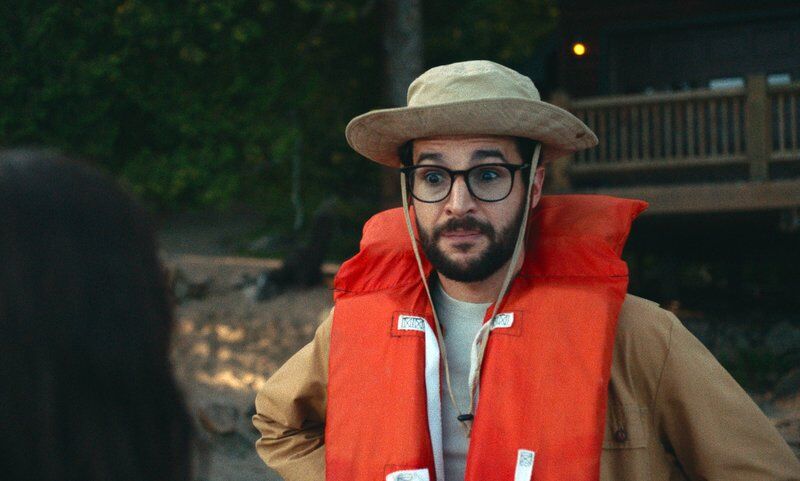(Come on. That title is alliterative genius. “Diabolically Disturbing Dogtooth Discussed and Digested”?!?! Okay, maybe it was a bit much now that I think about it.) Let’s just start this discussion with a simple sentence that will inform the rest of this discussion thoroughly: this film was written and directed by Yorgos Lanthimos. Blink. Blink. Yes? Yorgos Lanthimos? About 10% of you are like, AH YES. I see. 80% of you are like – and? And yet another 10% of you are just hitting the back button on your browser. WAIT COME BACK! Mr. Lanthimos is the guy who gave us Lobster, and The Killing of a Sacred Deer. Or if maybe you’d prefer something a little more mainstream that garnered Yorgos Oscar potential – The Favourite. Still no clue? Look. His movies are crazy complicated, almost 100% controversial mind-grist, and totally there to just break your brain. Intentionally.
So, for most of you, this film might be a little much. But if you enjoyed the way your brain hurt after some of his other films – SURE! However, I’m betting for most of you – you stumbled on Dogtooth, you didn’t mean to click it, and yet you watched all the way through because, WHAT THE HECK IS HAPPENING HERE? And now, you find yourself on this page because you typed the words, “what the hell just happened with the movie Dogtooth?” And voila, nice to meet you. Let me introduce myself. My name is Taylor Holmes, and here on THiNC. we find the craziest, most indie kind of mindjobs out there, and we discuss them. We unpack them. We argue about them. We try and figure them out. I mean, on my Lobster and Killing of a Sacred Deer discussion posts alone, we’ve had over a million reads, and hundreds and hundreds of comments. So Dogtooth! Let’s dive into it and see what we find.
Dogtooth Movie Walkthrough
The movie opens with a family. A family that happens to be living sequestered away from the rest of the world. Although it actually took me a good half of the movie to really understand this fact. The individuals in our family are Father (played by Christos Stergioglou). Mother (played by Michele Valley). Older daughter (played by Angeliki Papoulia). Son played by (Hristos Passalis). And younger daughter (by Mary Tsoni). Yeah, avant- garde isn’t even the half of it. This thing is a runaway social-psychological mental headcase of a research experiment.
But it’s safe to say that the three children have absolutely no knowledge of the outside world beyond the fence of their property. They’ll stay there safely on the property until they lose their dogtooth. (?!?) In the mean time, the kids spend their days challenging each other with endurance and pain filled games. (Fingers in hot water, etc.) When they are good, they get stickers, and stickers add up to allow for privileges. Oh, and did I mention that Father pays a security guard named Christina at his factory to have sex with the son? This, apparently, is educational? Or maybe keeps him in check? I’m unclear. Later, Christina trades older daughter a headband for sex. Later, the older daughter convinces the younger daughter to lick her shoulder. The idea is spreading through the family like a game of disjointed telephone (which, I think is the central idea of this film).
At one point, the kids become afraid of a passing stray cat in the garden. Son kills the cat with a pair of shears. The father, seeing an opportunity here, covers himself in fake blood and tells the kids that their long missing second brother had been killed by a cat……. the most dangerous of creatures. Then, after teaching them to bark on all fours in order to fend of cats, the family has a memorial service for the dead brother.
Upon Christina’s next return, she attempts to trade sex again with the elder daughter but is rejected. She doesn’t want the hair gel on offer. But she does demand the films that Christina has in her bag. Afterwards, older daughter memorizes the film’s dialog and recites it to herself. The father eventually finds the movies and beats her with one of the movies. And then he goes to Christina’s apartment and beats her with a VCR. (For those of you that are younger among us, a VCR is a Video Cassette Recorder which allowed for recording and playing of recorded material. (No, your DVDs can’t do that. That is true.)) And swears at her that he hopes her children will be corrupted by other bad influences. With Christina gone, the sexual deviation and frustration spirals – and ends up with brother and elder sister having sex. (Trust me, I think this is adding up to something. Just hold on. Actually, I’m not sure that it is now that I think about what’s left. hahaha.)
When the parents’ celebrate their wedding anniversary the two daughters do a dance routine. Eventually elder daughter does a dance routine from Flashdance – you know, from the movies that she got from Christina? – well, that completely disturbs the parents. Later that night, the older daughter is so disturbed by what has happened she bashes out one of her dogteeth and climbs into the trunk of her father’s car. After thinking that maybe she was attacked by another stray cat, they all get on all fours and bark. This is an attempt to scare away the cats that might be present. Right? See, logical. He drives to work, and leaves his car unattended, and we see the trunk of the car as the credits begin to roll.

Diabolically Disturbing Dogtooth Discussed and Digested
Lobster was weird. It was a movie about singles, and the arbitrariness of coupling in the face of a society that thinks singles are threatening. Killing of a Sacred Deer is all about Greek mythology and the burden of life debts and sin. But what the heck is this movie about? There literally can’t be an explanation can there be? Definitely… let’s see if we can figure this out together.
The overarching idea here is all about insular societies and our attempts to protect ourselves from social corruption. (Which a subtitle here could be: Why Homeschooling Doesn’t Do What You Think It Does.) Older daughter, having been impacted by the movies that were brought into the house, realized that there was more outside the house’s walls than her parents were letting on. She didn’t know what. But she did know there was more. What once was thought by the children to be a perfect family she realized it wasn’t so. She was awakening to a larger truth, a real epiphany. (This literally could be an indictment of overly protective families while simultaneously being an indictment on the corruptive influences of film?)
An important detail I didn’t discuss is the salt shaker and the telephone. You see, the parents named the telephone the Salt Shaker. Eh? But when she watched the movies, she learned directly that her parents were lying to her. The salt shaker was the salt shaker and not the telephone…or vice versa. This funny detail is actually really critical to the understanding of the movie. Yorgos is using a silly, and literal, example to exemplify a larger truth all teens undergo when they begin learning for themselves. You remember having this experience yourself. And eventually (if you haven’t already) you’ll also get to watch your own children experience this phenomena for themselves. We all have a moment when we say – oh wait, WHAT? – as we learn that our parents’ information wasn’t perfect. (I for one am still considering writing a book entitled “What I Saw At the Carnival” to tell the story of my being raised as a Pentecostal Pastor’s son. Should either be a great read, or my own pyre… I’m not sure which quite yet.) But this moment is seminal in all kids as they begin wrestling with knowledge, and forming their own insights for the first time.
My family regularly goes to plays (Alice in Wonderland, Shakespeare, etc.), musicals (Hamilton, Wicked, Les Mis), art exhibits (Monet, Rembrandt, Retna, El Mac, Shepard Fairey, etc.) symphonies (Mozart, Beethoven, Handel, etc.) and the like. And the number one tendency of kids who experience great works of art, like… I don’t know… say something like this:

Is for them to say to you, “What do you think it means?” And the worst thing that you can do as a parent, is to answer them. “Well son, it’s a discourse on the insanity of man’s inhumanity to man.” Yeah, no. I try to force my kids to experience the art and to come up with something. I still remember the first time I stood in front of a wall of Warhol’s soup cans… and I remember my dad and an art friend tell me it wasn’t art. That it didn’t say anything at all. But my 12 year old brain was like… well, uh, it definitely does say something. Maybe I didn’t then understand Andy’s views on the mass production of art and the impact of materialism in the modern world. Maybe I didn’t get the deeper meanings that modern art in general was going after. But I did feel something about the number of cans on the wall… the repetitions of the reds. Maybe I did see that maybe copying could be a form of flattery – or maybe not? (Banksy anyone?) But I do know that an opportunity was lost that day. So now, when I stand with my kids in front of a “stupid” painting – I let them stand and struggle with it, maybe they’ll be my teacher that day.
But obviously, Father and Mother didn’t get that particular memo. And as a result they dictated the family’s thoughts and opinions on a wide range of ideas and experiences. And, as a result, when new ideas came in, they were contagions. They polluted the family. And instead of discussing these ideas, wrangling with them… and discussing the family’s perspective in the face of these new ideas, they were affronted by them.
Family’s attempt to insulate. To create a false utopia of safety and stability. This only harms our children. Obviously, everything should happen in its season, or in its time. But to protect them from everything only makes them mentally weak and infirm. So weak as to crack and break at the first contradictory opinion or idea.
The literal ending of the film is dynamically open ended. Does she get out of the trunk the moment her father goes into work? Maybe. Does she flee her family and never see them again? Maybe. Does she stay in the trunk and eventually die? I don’t know. Maybe. Does she return to the family and apologize for her rebellion? Maybe. But the open endedness, which, is so hated by American audiences, is a real asset here. We consider not the specific details, but rather the larger metaphor and idea that we’ve been presented with. What am I doing inside my own family? What will my children think and do differently when they leave? What will become an affront to them? What will be appreciated? Hrmm. Good questions. And all require self examination that is critical in nature. And that in turn requires honesty with ones self. And self-honesty is really the toughest thing in the world to do. (And if you just snapped to – oh no, I’m totally honest with myself… you are the biggest and most delusional of us all.)
Personally, I did not like this movie. But I hated The Lobster and The Killing of a Sacred Deer at first either. (Loved The Favourite immediately). I’m sure this one will grow on me as you guys start commenting, and letting me know that I totally missed the entire point of the film! hahaha. Seriously, what did you guys think of it?
Edited by: CY



